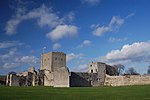Pewit Island (Portsmouth Harbour)
Hampshire geography stubsIslands of HampshirePortsmouthUninhabited islands of England

Pewit Island is a small island located in the north western section of Portsmouth Harbour. Historically it appears to have been connected to the mainland via a manmade shingle causeway, parts of which still exist. The island has been colonised by oak and blackthorn scrub and is home to species including sea lavender and golden samphire plants. The island is currently a Hampshire and Isle of Wight Wildlife Trust nature reserve.In 1857 plans drawn up to improve the defences of Portsmouth included building a fortification on the island. The plans were later modified in the face of improved artillery technology and the fortification was never built.
Excerpt from the Wikipedia article Pewit Island (Portsmouth Harbour) (License: CC BY-SA 3.0, Authors, Images).Pewit Island (Portsmouth Harbour)
Portsmouth
Geographical coordinates (GPS) Address Nearby Places Show on map
Geographical coordinates (GPS)
| Latitude | Longitude |
|---|---|
| N 50.831 ° | E -1.137 ° |
Address
Wicor Hard
PO16 8PP Portsmouth
England, United Kingdom
Open on Google Maps






